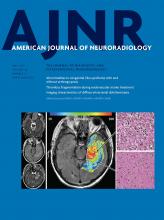Index by author
Ramkumar, S.
- Head and Neck ImagingYou have accessMRI-Based Texture Analysis to Differentiate Sinonasal Squamous Cell Carcinoma from Inverted PapillomaS. Ramkumar, S. Ranjbar, S. Ning, D. Lal, C.M. Zwart, C.P. Wood, S.M. Weindling, T. Wu, J.R. Mitchell, J. Li and J.M. HoxworthAmerican Journal of Neuroradiology May 2017, 38 (5) 1019-1025; DOI: https://doi.org/10.3174/ajnr.A5106
Ranjbar, S.
- Head and Neck ImagingYou have accessMRI-Based Texture Analysis to Differentiate Sinonasal Squamous Cell Carcinoma from Inverted PapillomaS. Ramkumar, S. Ranjbar, S. Ning, D. Lal, C.M. Zwart, C.P. Wood, S.M. Weindling, T. Wu, J.R. Mitchell, J. Li and J.M. HoxworthAmerican Journal of Neuroradiology May 2017, 38 (5) 1019-1025; DOI: https://doi.org/10.3174/ajnr.A5106
Rao, B.
- You have accessRegarding “MR Imaging of the Cervical Spine in Nonaccidental Trauma: A Tertiary Institution Experience”X. Wu, D. Durand, B. Rao and A. MalhotraAmerican Journal of Neuroradiology May 2017, 38 (5) E30; DOI: https://doi.org/10.3174/ajnr.A5098
Reddy, A.K.
- Head and Neck ImagingYou have accessPrognostic Predictors of Visual Outcome in Open Globe Injury: Emphasis on Facial CT FindingsU.K. Bodanapally, H. Addis, D. Dreizin, A.K. Reddy, J.A. Margo, K.L. Archer-Arroyo, S. Feldman, B. Saboury, K. Sudini and O. SaeediAmerican Journal of Neuroradiology May 2017, 38 (5) 1013-1018; DOI: https://doi.org/10.3174/ajnr.A5107
Reeder, K.
- You have accessReply:T.N. Booth, R. Jacob, C. Greenwell, K. Reeder and K. KoralAmerican Journal of Neuroradiology May 2017, 38 (5) E31; DOI: https://doi.org/10.3174/ajnr.A5111
Rees, John H.
- You have accessPerspectivesJohn H. ReesAmerican Journal of Neuroradiology May 2017, 38 (5) 851; DOI: https://doi.org/10.3174/ajnr.P0034
Reynolds, R.M.
- Pediatric NeuroimagingYou have accessBrain Development in Fetuses of Mothers with Diabetes: A Case-Control MR Imaging StudyF.C. Denison, G. Macnaught, S.I.K. Semple, G. Terris, J. Walker, D. Anblagan, A. Serag, R.M. Reynolds and J.P. BoardmanAmerican Journal of Neuroradiology May 2017, 38 (5) 1037-1044; DOI: https://doi.org/10.3174/ajnr.A5118
Rotzinger, D.C.
- FELLOWS' JOURNAL CLUBAdult BrainOpen AccessSite and Rate of Occlusive Disease in Cervicocerebral Arteries: A CT Angiography Study of 2209 Patients with Acute Ischemic StrokeD.C. Rotzinger, P.J. Mosimann, R.A. Meuli, P. Maeder and P. MichelAmerican Journal of Neuroradiology May 2017, 38 (5) 868-874; DOI: https://doi.org/10.3174/ajnr.A5123
The authors used CTA to assess arterial stenosis and occlusion in an ischemic stroke population arriving at a tertiary stroke center within 24 hours of symptom onset to obtain a comprehensive picture of occlusive disease pattern. Extra- and intracranial pathology, defined as stenosis of ≥50% and occlusions, were registered and classified into 21 prespecified segments. In the 50,807 arterial segments available for revision, 1851 (3.6%) abnormal segments were in the ischemic (symptomatic) territory and another 408 (0.8%) were outside it (asymptomatic). In the 1211 patients with ischemic stroke imaged within 6 hours of symptom onset, 40.7% had symptomatic large, proximal occlusions. They conclude that CTA in patients with acute ischemic stroke shows large individual variations of occlusion sites and degrees. Approximately half of patients have no visible occlusive disease, and 40% imaged within 6 hours show large, proximal segment occlusions amenable to endovascular therapy.
Rouchaud, A.
- FELLOWS' JOURNAL CLUBAdult BrainYou have accessClinical and Imaging Characteristics of Diffuse Intracranial DolichoectasiaW. Brinjikji, D.M. Nasr, K.D. Flemming, A. Rouchaud, H.J. Cloft, G. Lanzino and D.F. KallmesAmerican Journal of Neuroradiology May 2017, 38 (5) 915-922; DOI: https://doi.org/10.3174/ajnr.A5102
The authors retrospectively reviewed a consecutive series of patients with diffuse intracranial dolichoectasia and compared demographics, vascular risk factors, additional aneurysm prevalence, and clinical outcomes with a group of patients with vertebrobasilar dolichoectasia. Twenty-five patients had diffuse intracranial dolichoectasia, and 139 had vertebrobasilar dolichoectasia. Patients with diffuse intracranial dolichoectasia were older than those with vertebrobasilar dolichoectasia and had a higher prevalence of abdominal aortic aneurysms, other visceral aneurysms, and smoking history. Patients with diffuse intracranial dolichoectasia were more likely to have aneurysm growth. They conclude that the natural history of patients with diffuse intracranial dolichoectasia is significantly worse than that in those with isolated vertebrobasilar dolichoectasia.
Rundek, T.
- Adult BrainOpen AccessBrain Perivascular Spaces as Biomarkers of Vascular Risk: Results from the Northern Manhattan StudyJ. Gutierrez, M.S.V. Elkind, C. Dong, M. Di Tullio, T. Rundek, R.L. Sacco and C.B. WrightAmerican Journal of Neuroradiology May 2017, 38 (5) 862-867; DOI: https://doi.org/10.3174/ajnr.A5129








